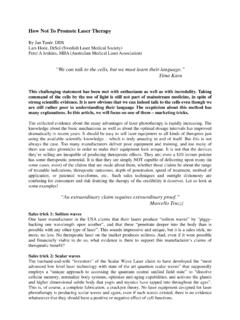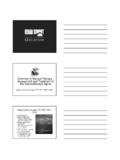Transcription of A Trial of Low Level Laser Therapy for Reduction of ...
1 A Trial of Low Level Laser Therapy for Reduction of tinnitus Symptoms Quittner , BAppSc (Physio), Healesville Physiotherapy, Victoria, Australia. e-mail: Background A Trial of Laser treatment for tinnitus was conducted to determine optimal treatment duration and frequency. Over the longer term we will endeavour to predict whether maintenance treatment will be required, and to predict which patients will benefit from Laser , by using a preliminary questionnaire. The Trial was not double blinded, as patients were charged a nominal fee to cover expenses, and it was judged as unethical to provide sham treatment to paying patients.
2 Trial participants were not routinely screened for somatosensory tinnitus , although some patients reported altered symptoms with varying jaw positions, or digital pressure around the temporo-mandibular joint or mastoid area. This article is written following interpretation of 32 patients tinnitus symptoms, which have received five treatments of infrared 400 milliWatt Laser to each ear. Twenty nine of thirty two patients ( ) have had some improvement in their tinnitus after the first 5 treatments, with duration of 10 to 40 minutes.
3 One patient had an improvement at the fourth treatment; however after increased treatment duration, demonstrated a slight increase in tinnitus . If the fifth treatment was excluded, the improvement would have been Maximum improvement per session achieved was 80% Reduction in symptoms. Improvement has included a decrease in perceived pitch and \ or volume, and improved acuity for conversation or listening to television. The improvement figures have been difficult to interpret, as each patient s maximum improvement occurred at different treatment duration (dosage), and an increase beyond their optimal dosage Level sometimes resulted in an overall decrease in improvement, which lowered the improvement percentage.
4 Two patients demonstrated no improvement, one of which had a 5% worsening of symptoms after the first treatment. The patient having the 5% worsening of symptoms claimed to have been confused with the visual analogue scale during the fist session, and corrected his reported position on the scale at the second and subsequent sessions. The first session score was left unchanged in the data calculations, resulting in the only recorded worsening of tinnitus for this Trial . Laser Type Tinnihelp is a dual 400 milliWatt 808 nanometre continuous infrared lasers with collimator for beam divergence of 20 degrees, manufactured by Unilaser, Denmark.
5 Dual 400 milliWatt 808 nanometre infrared lasers (GaAlAs) with collimator for beam divergence of 20 degrees, each Laser on a headset similar to headphones. Output power claimed 2 x 400mW continuous +\- 10%. Total output 800mW. Fig 1 Patient Selection Patients were located via advertising in the local newspaper, and a subsequent editorial based upon an interview of one patient. Prior to treatment all patients were given an information sheet, and a consent form. The patients were aware that all treatments would use an active Laser .
6 All patients were accepted into the Trial if they expressed an interest to be involved. All patients were informed that no guarantee of tinnitus Reduction was made by the clinic, and signed a form confirming their understanding. Thirty two patients (21 Male, 11 Female), 27 of which had bilateral tinnitus , were given Laser to each ear. One male patient has had severe tinnitus for over 28 years, and another male patient has been symptomatic for over 25 years. Neither patient has had any success with any other form of treatment, including a number of scientific trials.
7 Both patients had an initial improvement, with a Reduction in their tinnitus levels for the first time with any treatment, during this Trial . Protocol The protocol was determined after an internet search of previous research, and consideration of criticism of previous studies shortcomings. The Trial protocol was refined on an ongoing basis as treatment knowledge was attained. Our clinic was unable to conduct a double blind research study due to lack of funding, and our limited ability to deal with large numbers of people, as we only had access to one Laser unit.
8 Both ears were treated with the same dosage regardless of which ear was affected to avoid any possibility of vestibular disturbance due to uneven stimulation. It was decided that 5 treatments were to be given, and if no improvements were noted, Laser treatment would be discontinued. Treatment time was initially 10 minutes for the first session, however this was increased to 20 minutes as minimal improvement was found at the lower Level . Maximum treatment was 40 minutes, which did not further increase levels of improvement, and in some cases may have slowed or reversed improvements.
9 Treatment frequency was initially to be a treatment on alternate days; however this was changed to allow treatments on successive days, which tended to result in more rapid symptom change. If patients have had tinnitus without evidence of hearing deterioration, they were advised to have blood tests for zinc levels , and discussion was had with all patients in relation to having their ESR and C-Reactive protein levels measured to determine if any infections were present. The blood tests were advised as we have had experience of patients with infection flares being directly related to tinnitus levels .
10 The literature has reported that low zinc levels without hearing loss can be related to tinnitus . One patient enquiry resulted in us providing background information via e-mail, and the potential patient responded by self medicating with zinc supplementation (without blood test investigation), and he subsequently reported to us via phone call that his tinnitus had resolved completely. We never actually met this gentleman, and he is not included in our results. None of the Trial patients that undertook blood tests demonstrated any abnormalities.








